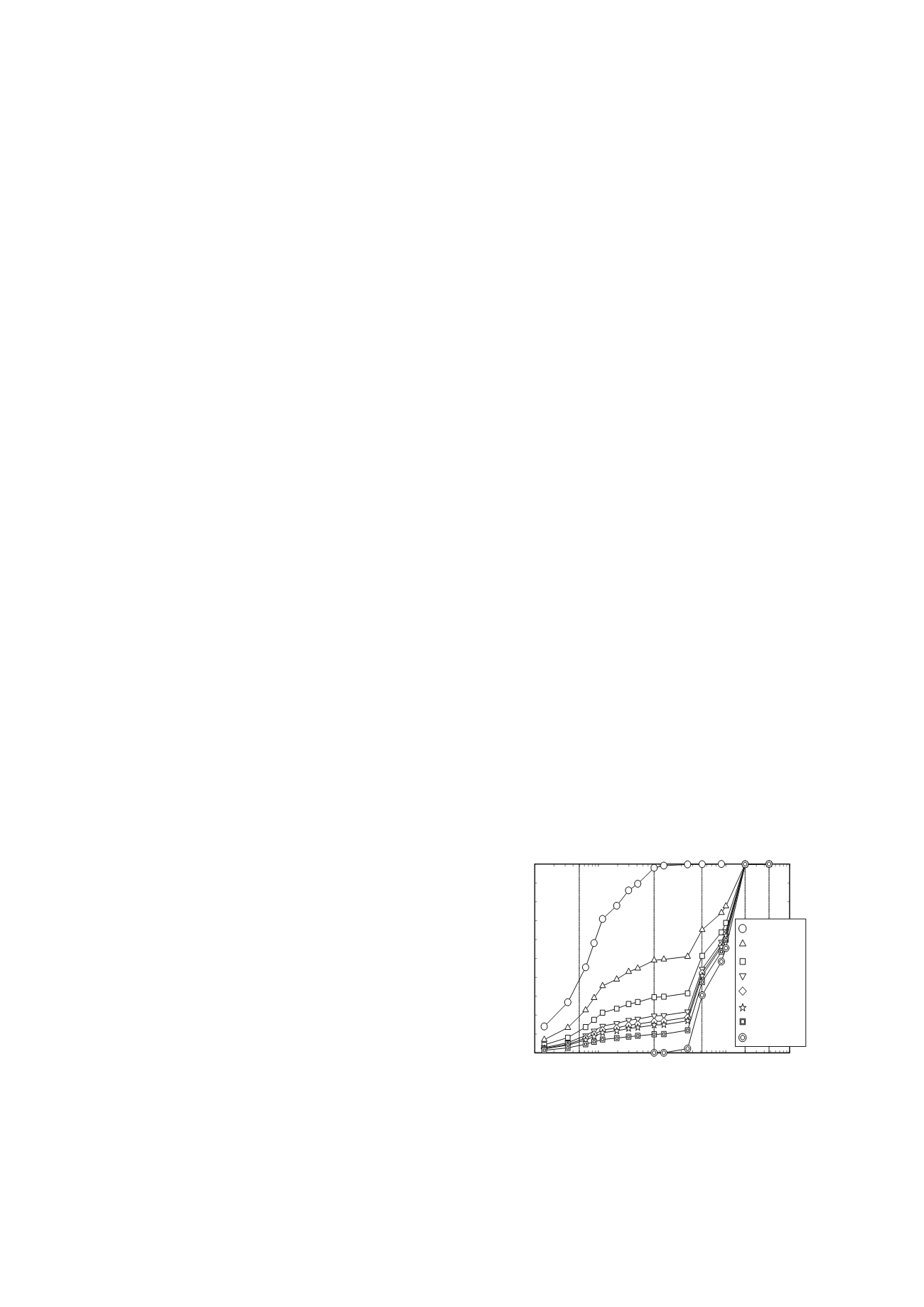
1551
Effects of Fines Content on Cyclic Shear Characteristics of Sand-Clay Mixtures
Les effets de la teneur en fines sur les caractéristiques du cisaillement répéte des mélanges de
sable et argile
Noda S., Hyodo M.
Yamaguchi University
ABSTRACT: The undrained cyclic shear behaviour of sand-clay mixtures with various fines content and compaction energy, has
been investigated with reference to the sand structure void ratio. For a low fines content, sand particles dominate the soil matrix,
whereas when the fines content is high, clay particles dominate the soil structure. For sand-clay mixtures, it was observed that the
matrix structure of the coarse particles has a large effect on the undrained cyclic shear strength characteristics, and that the density of
the sand structure is more significant than the fines content.
RÉSUMÉ : Le comportement au cisaillement cyclique non drainé des mélanges sable-argile avec diverses teneurs en fines etl’ énergie
de compactage ont été étudiés considerant l'indice des vides de la structure du sable. Pour une faible teneur en fines, les particules de
sable dominent la matrice de sol, tandis que, quand la teneur en fines est élevée, les particules d’argile dominent la structure de sol.
Pour les mélanges de sable et argile, on a observé que la structure de la matrice des grosses particules exerce un grand effet sur les
caractéristiques de résistance au cisaillement répéte, et que la densité de la structure de sable est plus significative que la teneur en
fines.
KEYWORDS: sand-clay mixtures, compaction energy, cyclic shear strength
1 INTRODUCTION
The gigantic 2011 Tohoku Earthquake with moment magnitude
M
w
9.0, caused extensive damage to life and property in the
Tohoku and Kanto regions in eastern part of Japan. In many
locations, there was severe damage to residential land
developed by cut and fill methods in hilly areas. In the Kanto
area, over ten thousand houses suffered from serious settlements
or tilting due to soil liquefaction. The foundation soils generally
contained a lot of fines.
A study was therefore carried out on natural clay and sand
mixed together in various proportions, giving a range of soil
structures, ranging from sand to clay dominating the soil matrix.
These were prepared by varying the amount of fines added. The
undrained cyclic shear behaviour of sand-clay mixtures was
then examined based on the concept of granular void ratio, and
the variation in cyclic shear strength with increase in fines
content was investigated. Based on the test results, a method for
a unified evaluation of the cyclic shear strength of soils
consisting of wide range of grain sizes (from sand to clay) was
proposed.
2 MATERIALS USED AND EXPERIMENTAL
PROCEDURE
2.1 Test Materials
Marine clay obtained from Iwakuni Port in Yamaguchi
Prefecture (Japan) and Silica sand with adjusted grain size
distribution were mixed in various proportions in order to form
a wide range of soil types, i.e., from sand to clay. Initially, No.
V5, No. R5.5, No. V6 and No. V3 Mikawa silica sands were
mixed in 1:2:2:5 ratios by dry weight in order to modify the
grain size distribution. The silica sand with adjusted grain size
distribution had maximum and minimum void ratios of
emax=0.850 and emin=0.524, respectively. For Iwakuni clay,
soil particles larger than 0.425 mm were removed by sieving.
Next, 8 types of soil mixture were produced by mixing the silica
sand with adjusted grain size and sieved Iwakuni clay in
different proportions based on dry unit weights. The
engineering properties of the samples used are given in Table 1,
and the grain size distribution curves are illustrated in Fig. 1. In
its natural state, Iwakuni clay has a fines content Fc=98.0% and
clay content Pc=38.8%. It has a plasticity index Ip=47.5,
indicating a clay with medium plasticity. Since Iwakuni clay has
a sand content of 2%, the fines content of each sample of the
sand-clay mixture shown in the table is smaller than the Iwakuni
clay content. From the table, when the fines content Fc>19.6%,
the soil mixture has activity, while when Fc<16.7%, the mixture
is considered as non-plastic.
0.001
0.01
0.1
1
10
0
10
20
30
40
50
60
70
80
90
100
Grain size, (mm)
P erc en t fin e r by w eight, (% )
0.005
0.075 0.42 2.0 4.75
Fc=98.0%
Fc=49.0%
Fc=29.4%
Fc=19.6%
Fc=16.7%
Fc=14.7%
Fc=9.8%
Fc=0%
Fig.1: Grain size distribution curves of samples us
2.2 Specimen Preparation
Samples with an Iwakuni clay content of 20% or greater, were
mixed at a water content of about twice the liquid limit, after
which they was placed in a pre-consolidation cell measuring


